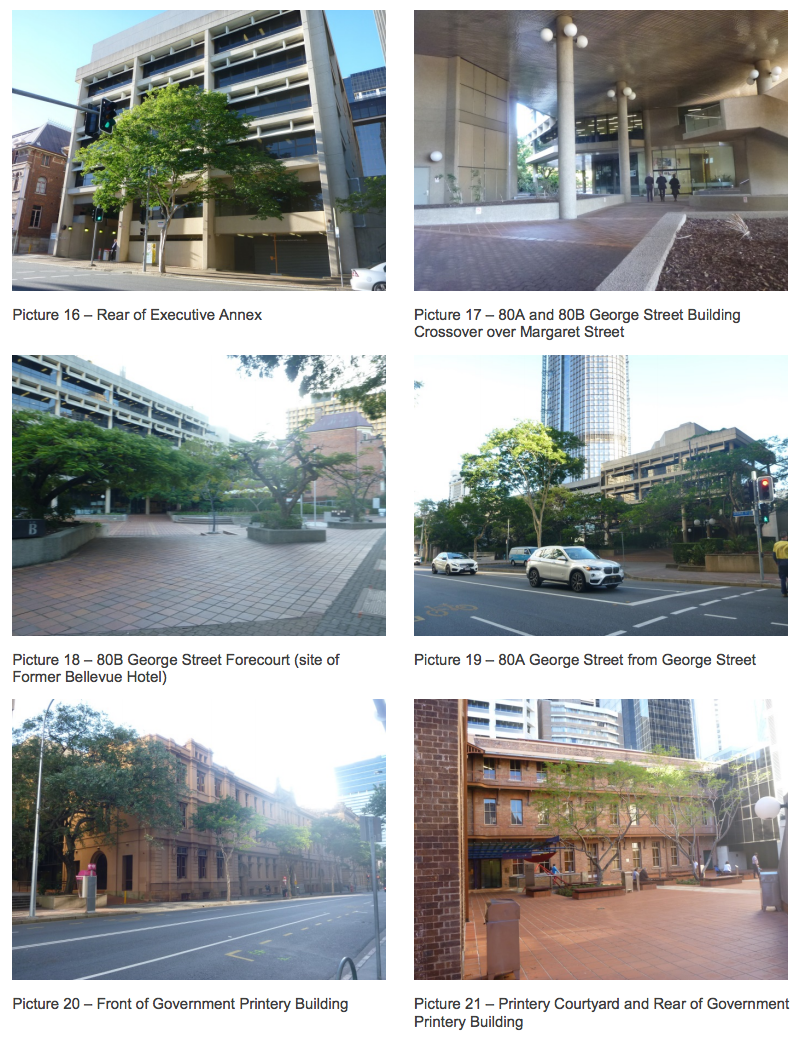It might only be the initial hoarding and very early branding concepts, but for Queenslanders the first plans for Queens Wharf signals the start of a new era.
The new Queens Wharf lodgement includes advertising plans alongside a detailed, staged demolition management plan for four non-Heritage buildings, bracing for Heritage buildings (retention works), installation of vibration monitoring equipment to the fabric of certain heritage buildings and dilapidation reports.
Initial advertising concept and placements with plans for 'monitoring equipment and hoarding' covers Queens Wharf Road, William Street, Mary Street, George Street, Margaret Street, and Elizabeth and Alice Streets. The Minister for Economic Development Queensland acknowledged receipt of the plans on 2 December, 2016.

While the proposed works do not involve demolition of any heritage buildings or features, there is potential for heritage impact to occur if the process is not managed appropriately. Therefore, included in the plans is complex vibration monitoring strategies and extensive bracing concepts to prevent any damage to surrounding Heritage sites including archaeological deposits that underpin the early significance of Brisbane.

A "skeletal remains" procedure manual is also enclosed, as is standard for significant site demolition.

QW Hoarding StyleguideIn a presentation to the State Government in October, Destination Brisbane Consortium in conjunction with Tomahawk Creative lodged Queen's Wharf hoarding initial creative plans including initial messaging, messaging scales, branding and visual hoarding to be placed around the city.

Queens Wharf hoarding conceptsThe key advertising features a "Brisbane Is..." concept that will feature multiple signboards with key attributes of the city with words inserted such as "developing" and "changing".
Demolition Plans
Stage 1
75 William Street (Neville Bonner Building)
100–102 George Street – Executive Building, including the Executive Annex (referred to as Buildings 4 and 1 in the Demolition Management Plan);
80A George Street (Building 3) including the section over Margaret Street (referred to as Buildings 3 and 3A in the Demolition Management Plan).
Stage 2
19 − 80B George Street
Neville Bonner Building
This building is sited between Queen’s Wharf Road, William Street and Margaret Street. William Street and Queen’s Wharf Road partially comprise the Early Streets of Brisbane archaeological place. The former DPI Building is adjacent to the building to the northwest. It is understood that large excavator plant will be used to demolish the Neville Bonner Building, commencing at the Queen’s Wharf Road frontage and moving towards William Street. The building will be demolished to footpath level to afford the continued support of the adjacent roads. It is confirmed that no demolition is proposed within the site of the adjacent former DPI Building as part of this work.

Proposed MitigationIt is understood that the demolition of the Neville Bonner Building will follow the proposed methodology in the Demolition Construction Management Plan including erection of perimeter encapsulation through the use of covered scaffolding to restrict the potential for loose ‘flyaway’ materials; and subsequent demolition of the building from roof down to street level. Providing the protective scaffolding is erected, it is considered that there is low potential for direct physical impacts to the building.

The demolition of this building has the potential to impact on the former DPI building, including the brick structural remains of the 1916 extension. It is unlikely that the demolition of the building will impact on the archaeological potential of the former DPI Building site. There is low potential for impact to the Early Streets of Brisbane archaeological place. The demolition plan suggests that removal of trees from the William Street frontage of the building (on the footpath) may also occur in conjunction with this demolition. Impacts may be physical and direct, resulting from loose materials, or indirect resulting from vibration. The area surrounding the former DPI Building has been assessed as having high archaeological potential, with any artefacts uncovered likely to be of State significance. It is unlikely that demolition of the Neville Bonner to ground level will impact on the archaeological values.
Executive Building
This building comprises land on the block bounded by Margaret, William and George Streets, and Stephens Lane. The former Government Printing Office is sited to the north-west of the building. It is understood the building will be demolished to George Street level, and planter beds, pavers and trees will be removed.
Executive Annexe
This building comprises land on the block bounded by Margaret, William and George Streets, and Stephens Lane. It is associated with, and connected to the Executive Building.
It is understood that the demolition of the Executive Annexe will follow the proposed methodology in the Demolition Construction Management Plan, including erection of perimeter encapsulation through the use of covered scaffolding to restrict the potential for loose ‘flyaway’ materials; and subsequent demolition of the building from roof down to street level.
Department of Public Works Building
The Department of Public Works Building comprises one large structure sited on two blocks of land (street address 80A and 80B George Street) and incorporating the use of an elevated section that extends over Margaret Street.
It is noted that 80B George Street will potentially be reused as site offices in the short-term, and is therefore not proposed for demolition under this current scope of works.
Bracing and Vibration Monitoring
It is understood that three vibration monitoring stations, one tiltometer, one piezometer, and one inclinometer will be placed at various locations at Harris Terrace to prevent cultural significance of Harris Terrace and the Mansions. All Heritage buildings surrounding demolition sites will be braced.

These stations are to continue monitoring vibration throughout the demolition and later excavation phases of the project. A dilapidation survey is also being prepared for the building, to understand its baseline condition for monitoring throughout the life of the project.
















